This article needs additional citations for verification .(August 2007) |

The giant squid's elusive nature and fearsome appearance have long made it a popular subject of legends and folk tales. Its popularity as an image continues today with references and depictions in literature, film, television, and video games.
Contents
- Books and comics
- Film and television
- Film
- Television
- Music
- Artists
- Albums
- Songs
- Video games
- Statues and sculptures
- Miscellany
- See also
- References
Often, the giant squid is represented as being in dramatic, evenly matched combat with a sperm whale. However, this powerful image is no longer considered accurate given the evidence that exists for a simpler predator-prey relationship between whale and squid, with the whale being the predator and the squid the prey, though sucker scars have been seen on sperm whale skin. [1]


